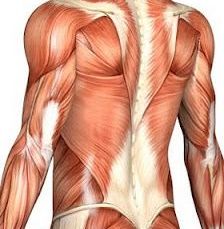Soft tissues are muscles, tendons (connections from muscle to bone), ligaments (connections from bone to bone), and intervertebral disks (cushions between the bones of the spine).
Things like trauma, fall, sudden stretching of a contracted muscle (lifting) or repeated activity/exposure may produce pressure, pinching, cutting, tearing, vibrating, loading, twisting, or stretching that may result in damage/tearing of soft tissues. Damage, resulting in small amounts of cell death, produces inflammation which irritates nerve endings, causing pain. Additionally, when soft tissues suffer either acute or repetitive injury, there is a disruption in blood flow the local tissue. Since blood supplies food and oxygen to all cells, injury is associated with a local “energy crisis” in the cells/tissues. In muscle, energy from blood is needed to both “link up” muscle fibers to create contraction, and to “unlink” muscle fibers for muscle relaxation. When there is decreased blood flow, contracting muscle fibers may fail to “unlink” and prolonged contraction (spasm) may ensue. This prolonged contraction, in turn, slightly crushes blood flow to the same area of affected muscle, exacerbating the problem. According to Travell and Simmons, this how trigger points form. Muscles with trigger points—the tight knots and bands that may be found in muscles, including those of the low back—are often abnormally shortened, with the increased tone and tension associated with spasm.[11]
For more about trigger points and muscle spasm, click here.
In the in the back and in spine, there also tendons (connections between muscle and bone) and ligaments (connections from bone to bone). Injury or tears (large or small) to tendons or ligaments can produce the same appropriate or inappropriate inflammation and or/pain signaling to the brain. Scar tissue, the result of inflammation, may tighten or loosen tendons or ligaments. The low back needs to remain upright, against gravity, and therefore needs support. Tendons and ligaments are part of the low back’s support system. If tendons and ligaments loosen or tear, the back may lose needed support. This instability then allows gravity to worsen the wear and tear forces on the low back, thus increasing inflammation and/or pain.
X
1 Anderssen GBJ. Frymoyer JW (ed.). The epidemiology of spinal disorders, in The Adult Spine: Principles and Practice. New York: Raven Press; 1997:93-141.
2 Cunningham LS, Kelsey JL. Epidemiology of musculoskeletal impairments and associated disability. Am J Public Health. Jun 1984;74(6):574-9. [Medline].
3 National Center for Health Statistics (1977):. Limitations of activity due to chronic conditions, United States. Series 10, No.111. 1974..
4 National Center for Health Statistics (1975):. Physician visits, volume and interval since last visit, United States. 1971. Series 10, No.97.
5 Nachemson Al, Waddell G, Norland AL. Nachemson AL, Jonsson E (eds.). Epidemiology of Neck and Low Back Pain, in. Neck and Back Pain: The scientific evidence of causes, diagnoses, and treatment. Philadelphia: Lippincott Williams & Wilkins; 2000:165-187.
6 Mayer TG, Gatchel RJ. Functional restoration for spinal disorders: The sports medicine approach. Philadelphia: Lea & Febiger; 1988.
7 Biering-Sorenson F. Low back trouble and a general population of 30-, 40-, 50-, and 60–year-old men and women. Dan Med Bull. 1982;29:289-99.
8 Damkot DK, Pope MH, Lord J, Frymoyer JW. The relationship between work history, work environment and low-back pain in men. Spine (Phila Pa 1976). May-Jun 1984;9(4):395-9. [Medline].
9 “Acupuncture Energetics: A Clinical Approach for Physicians”. Joseph M. Helms. Medical Acupuncture Publishers; 1st Edition. (1995)
10 “Foundations of Chinese Medicine: A Comprehensive Text for Acupuncturists and Herbalists”. Giovanni Maciocia. Churchill Livingstone; 2 Edition (July, 2005).
11 “Travell & Simons’ Myofascial Pain and Dysfunction: The Trigger Point Manual”. David G. Simons, Janet G. Travell, Lois S. Simons, Barbara D. Cummings. Lippincott Williams & Wilkins; 2 edition (1998)
12 “Traditional Chinese Medicine Cupping Therapy”. Ilkay Chirali. Churchill & Livinstone; 2 editioin (2007)
13 Argoff CE, Wheeler AH. Backonja MM, ed. Spinal and radicular pain syndromes. Philadelphia, WB Saunders: Neurologic Clinics; 1998:833-45.
14 Wheeler AH. Diagnosis and management of low back pain and sciatica. Am Fam Physician. Oct 1995;52(5):1333-41, 1347-8.
15 Wheeler AH, Murrey DB. Spinal pain: pathogenesis, evolutionary mechanisms, and management, in Pappagallo M (ed). The neurological basis of pain. New York: McGraw-Hill; 2005:421-52.
16 “Essentials of Musk Care”
17 Mooney V. Presidential address. International Society for the Study of the Lumbar Spine. Dallas, 1986. Where is the pain coming from?. Spine (Phila Pa 1976). Oct 1987;12(8):754-9. .
18 Waddell G. 1987 Volvo award in clinical sciences. A new clinical model for the treatment of low-back pain. Spine (Phila Pa 1976). Sep 1987;12(7):632-44.
19 Frymoyer JW. Back pain and sciatica. N Engl J Med. Feb 4 1988;318(5):291-300.
20 Argoff CE, Wheeler AH. Backonja MM, ed. Spinal and radicular pain syndromes. Philadelphia, WB Saunders: Neurologic Clinics; 1998:833-45.
21 Mooney V. Presidential address. International Society for the Study of the Lumbar Spine. Dallas, 1986. Where is the pain coming from?. Spine (Phila Pa 1976). Oct 1987;12(8):754-9.
22 Wheeler AH, Hanley EN Jr. Nonoperative treatment for low back pain. Rest to restoration. Spine (Phila Pa 1976). Feb 1 1995;20(3):375-8. [Medline].
23 Jensen MC, Brant-Zawadzki MN, Obuchowski N, Modic MT, Malkasian D, Ross JS. Magnetic resonance imaging of the lumbar spine in people without back pain. N Engl J Med. Jul 14 1994;331(2):69-73

